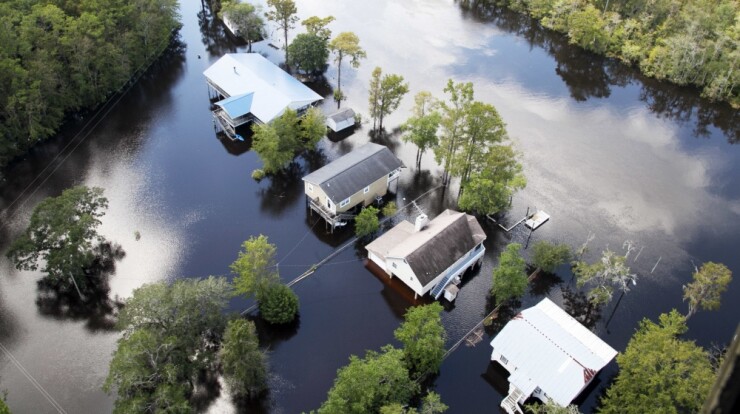With floodwaters still rising in parts of the Carolinas, the devastation wrought by Hurricane Florence may spur Congress to enact legislation that will help mitigate such damage in the future.
Nothing would make Alan Rubin happier.

Rubin, a principal with Blank Rome Government Relations LLC and a member of the firm’s severe weather emergency recovery team, accompanied the Federal Emergency Management Agency to New Bern and Wilmington, North Carolina, on Saturday and Sunday.
“It was pretty destructive,” Rubin said of what he observed.
North Carolina officials are doing an “incredible job” of moving quickly into recovery efforts, Rubin said, adding, “There’s not much they can do until the flooding is over in South Carolina.”
Hurricane Florence made landfall around 7:15 a.m. Sept. 14 near Wrightsville Beach, North Carolina, about 20 miles east-southeast of Wilmington.
Although Florence was a major Category 4 hurricane as it approached the Carolinas, it slowed before impact and struck Wrightsville Beach as a Category 1 hurricane with winds around 90 mph.
Water, not wind, was Florence's main weapon. Dumping rain for days, Florence flooded cities and farms, and is still pushing rivers over their banks. At least 43 deaths had been counted in North Carolina, South Carolina and Virginia as of Tuesday.
Early damage estimates from insured and uninsured losses in North and South Carolina are estimated at $40 billion, plus an additional $4 billion in economic losses, Rubin said.
A much-needed measure that will help mitigate the magnitude of such losses in the future will be available soon, he said, adding that it could also bolster the bond ratings of state and local governments.
Congress is poised to pass the Disaster Recovery Reform Act of 2018 in H.R. 302, which Rubin said will address disaster mitigation and funding for its implementation by FEMA. The bill would also reauthorize the Federal Aviation Administration for five years.
After seeing some of Florence’s devastation first hand in North Carolina, Rubin said he believes people will accept measures that would harden and raise structures and protect them from future disasters, especially those who have experienced repeated losses.
“I think people are ready to take a look at this and say an ounce of prevention is worth a pound of cure,” he said. “We’re finally getting to the point where people recognize that we can’t survive on emergency relief and we have to start thinking about resiliency.
Rep. Bill Shuster, R-Pa., chairman of the House Transportation and Infrastructure Committee, called on Congress to approve the bipartisan legislation in an Investor’s Business Daily
“It costs less to prevent and minimize damage and to strengthen our communities than it does to simply spend resources on recovery afterward - a common-sense approach but not one that our federal programs currently emphasize,” Shuster wrote. “Facilitating and incentivizing mitigation is the most effective means of bending the cost curve for disasters.”
According to the
“I’m very excited about it,” said Rubin, who counseled lawmakers on what should be included in the bill based on his experience with multiple natural disasters.
That experience includes working with officials post-Hurricane Andrew, a category 5 storm that decimated south Florida in 1992 and destroyed 165,000 homes. It caused about $46 billion of damage in today’s dollars and led Florida to implement some of the strongest building codes in the country.
“The place looked like it was nuked,” Rubin said of the damage created by Andrew’s winds. “The land wasn’t inundated by water.”
Strengthening building codes, he said, helped mainland Florida stave off massive damage from Hurricane Irma in September 2017.
Rubin said he expects measures such as stronger building codes and requiring building to be built higher to withstand flooding will also help communities “a great deal” in protecting their creditworthiness.
“People will actually start looking at green bonds,” he said, adding that federal, local and private funds can be leveraged to pay for projects that address resiliency and the increase in severe weather that some believe is driven by climate change. Green bonds are an asset class that attract investors interested in socially responsible investing.

Rubin also said there are circumstances where pre-planning would address some known conditions such as the rain-driven flooding some areas of Carolinas experienced with Florence.
“I don’t think anyone can be prepared for 40 inches of rain and inland flooding in vast rivers and lakes,” he said. “That’s part of North Carolina’s charm that they have all these lakes and rivers – some areas are called lowlands for a reason. They are very pretty but people have to think about how to address living in this environment and make it part of their economic development going forward.”
Florence could also impact some credits where parts of the Carolinas were unprepared for Florence’s impacts, including areas that never flooded before. That’s where rating agencies are monitoring the extent of the damage, particularly to public infrastructure.
“We continue our process of contacting issuers we believe could have potential credit-related events associated with the storm,” S&P Global Ratings analyst Bianca Gaytan-Burrell said Tuesday. “For both local governments and utilities we believe the affected issuers are mostly located along the North Carolina coastline where the storm came ashore near Wilmington, N.C., and where concentration of the damage and flooding appears greatest.”
In some instances, if there’s an indication of extreme or prolonged fiscal stress in response to damage or flooding from the storm, S&P said it may place ratings on CreditWatch with negative implications or modify stable outlooks to negative.
S&P said typical credit-related impacts from hurricanes can include inability to treat water and wastewater for an extended time, a permanent loss of customer base, immediate loss of revenues, unexpected capital costs, and cash flow problems from financing cleanup costs before FEMA reimbursements or grants are received.
Geographically, S&P said its efforts are focused in New Hanover, Onslow and Brunswick counties in North Carolina.
S&P said it is not yet known whether the Cape Fear River – a source of drinking water supply in east central North Carolina - has been “fouled” by the coal ash from Duke Energy's nearby facilities.
“We view this systemic risk as potentially most detrimental to credit quality, and will look to understand this aspect of creditworthiness in addition to any short-term financial effects as we make contact with issuers,” said Gaytan-Burrell.
As far as utilities are concerned, S&P said it expects the costs of restoring service, the cost of replacement power, and long-term capital costs for damages and customer dislocations will be manageable or minimal.
“While we also understand additional flooding could still occur as some waterways are expected to rise further, we don't anticipate significant electric service disruptions or damage,” Gaytan-Burrell said. “As a result, we do not expect any rating actions on U.S. retail and wholesale electric, cooperative electric, and combined utility issuers in North Carolina or South Carolina.”
S&P said it believes local government obligors that could experience potential credit impacts include the North Carolina counties of Craven, Bertie, Edgecombe County, Halifax, Hertford, Northampton, Onslow, Bladen, Cumberland, Duplin, Lenoir, Pitt, Robeson, Sampson, Wayne, New Hanover, Carteret, Dare, Pender, and Brunswick.
Municipalities in North Carolina that could be impacted are Greenville, the city of Wilmington’s stormwater system, Fayetteville, Goldsboro, and the Town of River Bend.
North Carolina utilities S&P is watching include the Cape Fear Public Utilities Authority, the Brunswick County water and sewer system, the Onslow Water and Sewer Authority, and the Town of Oak Island’s water and sewer system.
Public power utilities under review include: Brunswick Electric Membership Corp., North Carolina Eastern Municipal Power Agency, North Carolina Electric Membership Corp., and power systems owned by the cities of Concord, Fayetteville, Greenville, Monroe, and Shelby.
In South Carolina, S&P said public utilities being reviewed for impacts include: Central Electric Power Cooperative Inc., Piedmont Municipal Power Agency, the state-owned South Carolina Public Service Authority – also known as Santee Cooper – and municipal power services owned by the cities of Camden, Easley, Greenwood, Greer, Newberry, and Rock Hill.

Although rising floodwaters could impact inland issuers, S&P said the credit effects there are probably more short-term and cash-flow related as opposed to being systemic and long-term.
Because of state and federal disaster declarations, S&P said it expects most cleanup and repair costs to eventually be reimbursed by either insurance coverage or FEMA.
North Carolina Gov. Roy Cooper said Monday that 27 counties have been approved for federal assistance for uninsured and underinsured damage resulting from Hurricane Florence.
Approximately 80,000 people have registered for disaster assistance and more than $26 million in federal disaster assistance has been approved for individuals and families, he said.
“Florence is gone but the storm’s devastation is still with us,” Cooper said, adding that the state has shifted to full-time recovery efforts.
In its latest estimate, Moody’s Analytics said it believes Hurricane Florence’s costs have risen to between $38 billion and $50 billion, based on damage to property, vehicle losses and lost output – losses that result in “a more disruptive storm than its strength and path may have implied.”
“Many of the areas that experienced flooding in the aftermath of Hurricane Matthew are enduring similar tribulations this fall, but the footprint appears to be significantly broader following Florence, stretching about 200 miles west from the North Carolina coast and spanning 150 miles from north to south, extending into South Carolina,” according to analyst Ryan Sweet and researcher Adam Kamins. Matthew struck the area in October 2016.
The pair estimates most damage is to single-family homes based on the destruction associated with similar past storms and the value of single-family housing in affected counties.
“These losses will no doubt be exacerbated by a lack of flood insurance,” they said.
With flood insurance coverage lacking largely because of outdated flood maps that have allowed many homeowners to remain uninsured despite the risk, they said it will be more difficult for the region to be made whole.
“This problem mirrors the types of issues that plagued rebuilding efforts during Hurricane Harvey and speaks to the growing ineffectiveness of the National Flood Insurance Program,” Sweet and Kamins said.
Rubin said the bill before Congress will help mitigate flooding and repeat events.
“It makes a huge difference when you have different revenue streams” for recovery and mitigation, he said.
In North Carolina, Rubin said an example of one problem that has emerged is pollution in flood waters from pig feces from farms that didn’t have appropriate sanitation to deal with flooding.
As many as 50 man-made pits called lagoons that collect animal waste were flooded, according to state officials.
“Some of the [federal] preparedness and recovery money can give them opportunities to come up with better systems so that if it does flood again there won’t be the environmental nightmare they have today,” Rubin said.





